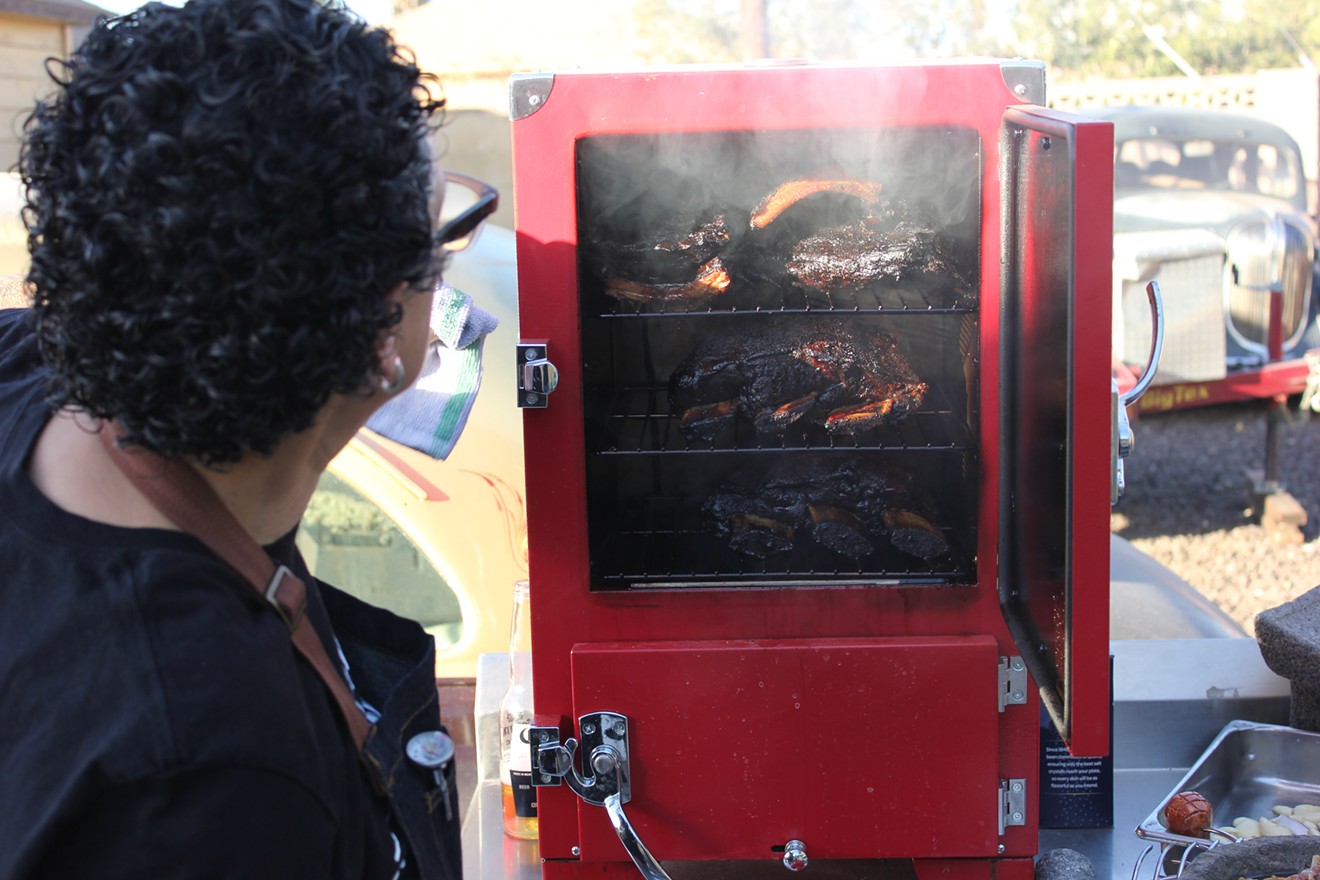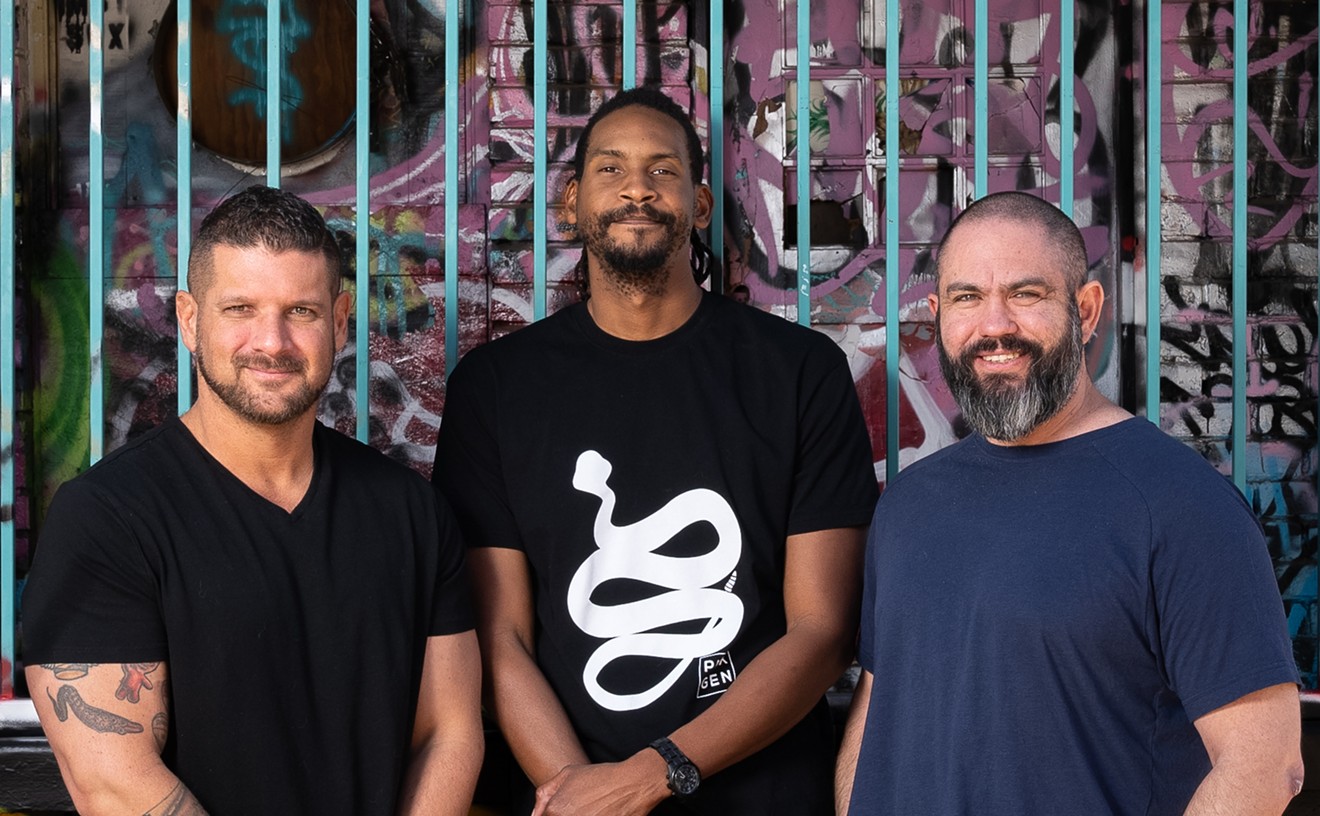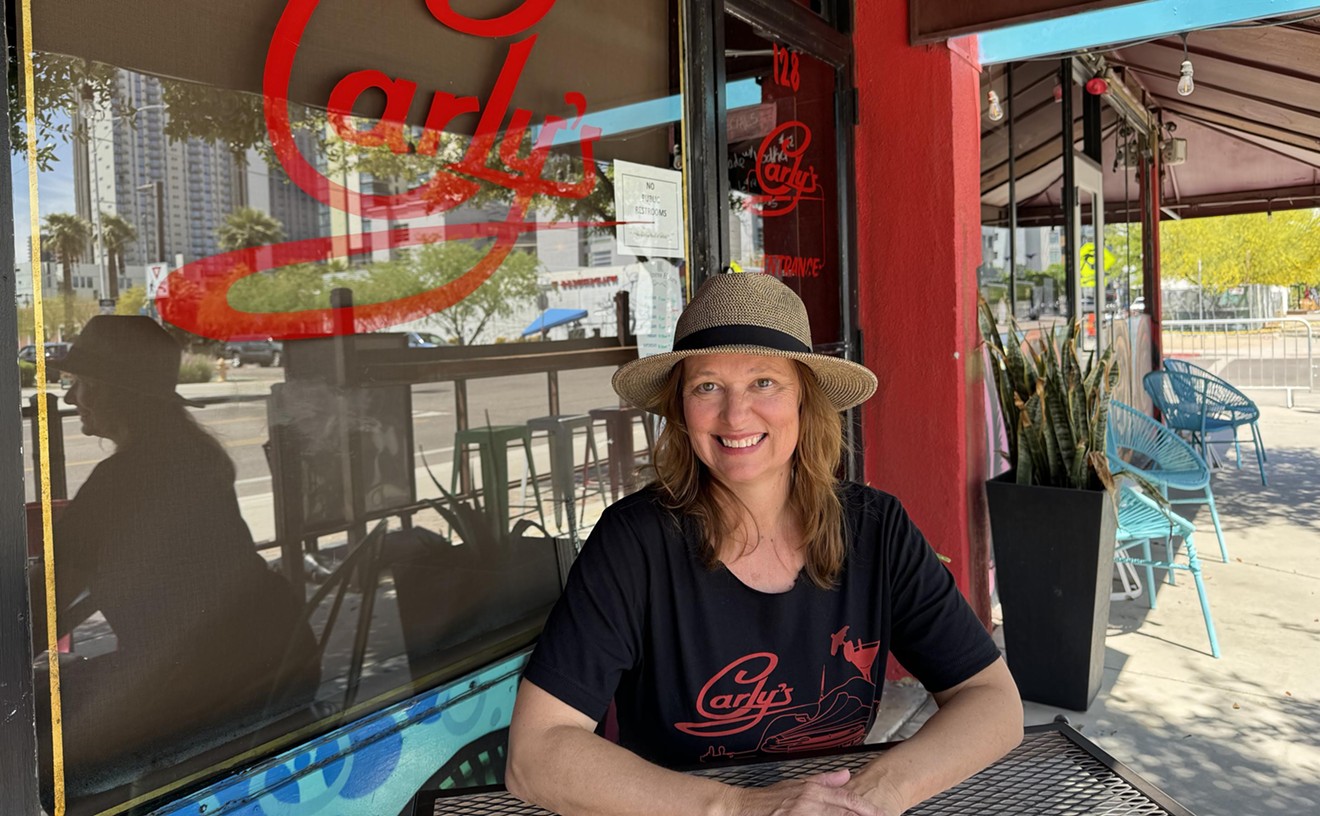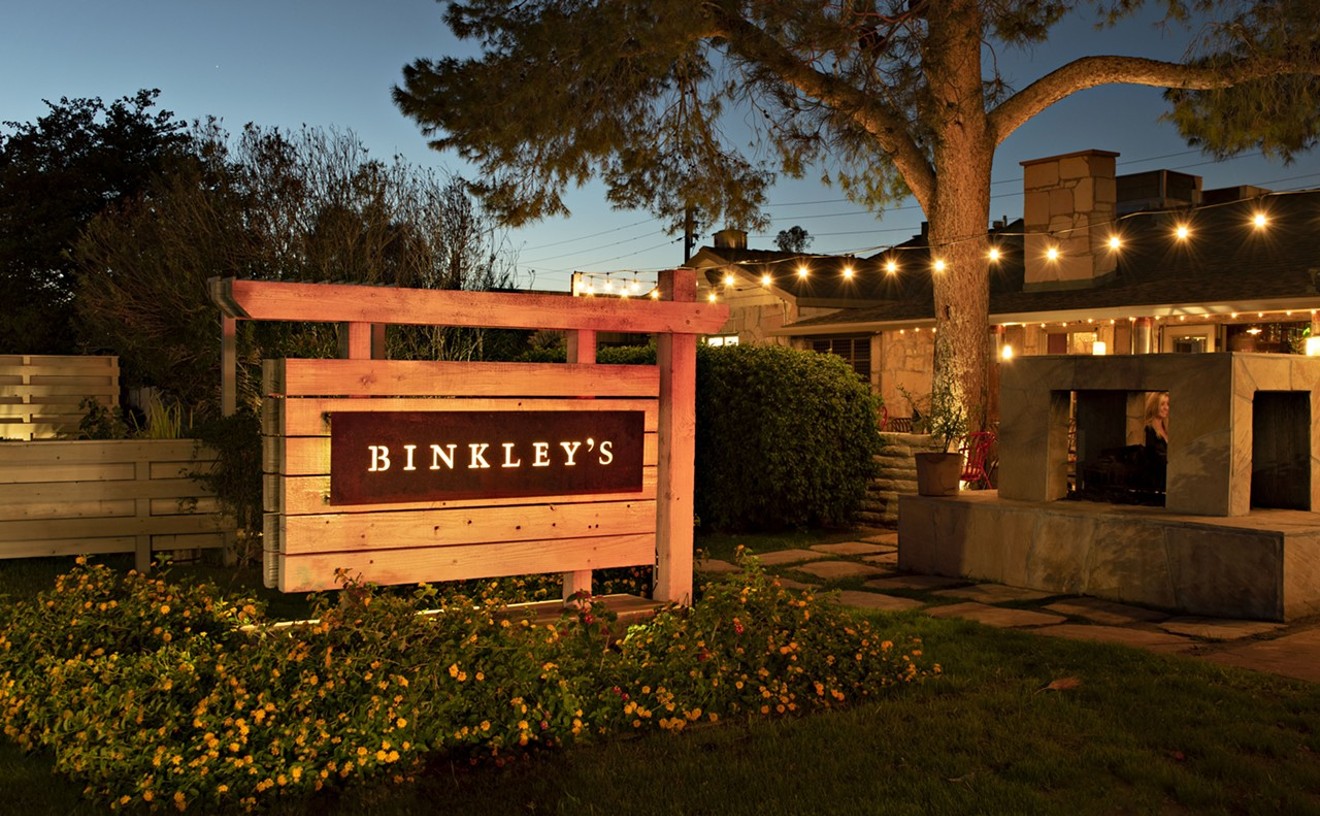Silvana Salcido Esparza — Phoenix’s longtime top Mexican chef who is perennially acknowledged as one of the best in America — wants to open a barbecue joint. She has had the playlist for this future barbecue restaurant set for seven years. Lately, Esparza has been looking around Phoenix for a location. She has even started to test recipes. “Mexican barbecue is the shit,” she says. “It’s like American barbecue but better.”
Her style of barbecue, though, isn’t Mexican.
It’s a fusion of Mexican and American.
“Our sauces were made for barbecue,” Esparza says, referring to Mexican sauces. “We cook barbecue with barbacoa. So it’s a natural evolution to use the better American techniques with the better Mexican-style food.”
Esparza conducts the testing for her future barbecue joint in a yard behind Barrio Café. The yard is littered with cars Esparza casually collects, vintage Bombs from 1938 to 1953. Stop by on the right afternoon, and you can smell fruit wood burning, hear country tunes flowing, and see sunlit smoke rising.

Silvana Salcido Esparza and her nephew and GM Antonio Cruz Esparza working the grills and smokers
Chris Malloy
She doesn’t think Mexico gets enough credit for influencing American barbecue. Conventional wisdom holds that barbecue came to the United States from the Caribbean. Writer Harold McGee notes that the word barbecue comes from the Spanish word barbacoa, born in the Caribbean from a Taíno word meaning “a framework of green sticks suspended on a corner post, on which meat, fish, and other foods were laid and cooked in the open over fire and coals.” This etymology is often used to emphasize American barbecue’s Caribbean lineage. No such Mexican link is widely championed.
Enter Silvana.
Silvana not only has dreams of opening a barbecue joint, she dreams about how barbecue concepts bled into the American West from Mexico. She cites the pit-cooking mastery of the Chichimeca, a pre-Columbian people who lived north of the Aztecs, and examples like how close American barbecue's baked beans are to Mexican frijoles charros. Given the black holes and blank spaces in food history, such a link seems possible.
“The word barbacoa is of course not Mexican in origin,” Silvana says. “But what, do you think that before the Spaniards got to Mexico the Mayans weren’t cooking cochinita pibil in a pit for over a thousand years?”
Silvana opens the offset's steel hatch. Smoke billows. She removes a tin of pork shoulder. Char encrusts the top, which rises from juices rivering like thin magma. This is the ancient cochinita pibil — pork marinated in sour orange sauce and slowly cooked. Cochinita pibil is one of Silvana's signature dishes. This is the first time she's made it in an American smoker.
“Yeaaaaahhhhh, Johnnnnyyyy!” she bawls to the blue sky.
The playlists has shifted. From the laptop speakers on the roof of a 1953 Chevrolet Bel Air, the hood sporting tequila bottles, a plucky guitar comes twanging. The music had been Norteños from North Mexico. Now, Johnny Cash’s unmistakable voice starts darkly crooning.
“I hear the train a comin’. Rollin’ round the bend...”
Silvana’s dream barbecue restaurant, like her playlist, will fuse Mexican and American styles. Silvana knows barbecue. For 20 years, she has had a house in Baja California where she smokes meat in custom pits. Long ago, she learned how to barbecue while backpacking through Mexico.
Once, Silvana lived for six months in a hut by the ocean in Quintana Roo. “I learned how to cook cochinita pibil from a Mayan family,” she says. “I would get up at 2 in the morning, walk two miles to the road, wave somebody down to take me to town so I could help the family and learn how to make this.”
The Mayan family cooked suckling pigs and turkeys in a barbecue pit. They stuffed the turkeys with eggs and coated them with relleno negro (a variety of smoked chile paste). These are the same kind of folks who have been cooking the dish since prehistory. Silvana helped the family sell at the market. She also grilled iguanas with a Zapotec family in another of her many help-and-learn relationships.
While backpacking, Silvana observed variations in smoking. “There’s different styles of barbecue in regions of Mexico,” she says. Asked to pin her own barbecue style, she says, “I just make shit up.”
After a few beers, the sun has dipped behind a roof. Barrio Café staff and friends have been stopping over, mixing Micheladas in beer bottles and chatting. Now, the long-awaited moment has come. Silvana’s latest experiment in barbecue is ready.
In keeping with the ethos of Barrio Café Gran Reserva, which she just changed to a 50 percent vegan menu, Silvana has smoked vegetables: yams, scallions, carrots, and stuffed peppers. Her dream barbecue spot will barbecue lots of vegetables. “When you smoke yams and vegetables,” she says, “it gives you the satisfaction that [vegan] people miss out on.”
Her indirect approach to "barbecue sauce" starts with a vegan mole.
Smoked yams — together with figs — are at the mole's heart. But the mole assumes a new character once she “marries” it with Ají Amarillo chile paste. It morphs yet again when she adds ingredients common to barbecue sauce. It even tastes a lot like barbecue sauce. "If you look in a mole, there's 10 to 16 ingredients," she says "If you look at a barbecue sauce, there's 10 ingredients. In essence, they're kind of the same."
Like any good barbecuer, Silvana employs rubs. When I was in, she skipped her usual assertive mix of chiles and cumin for a simple salt, pepper, and garlic rub, one that wouldn't smother the meat or the barbecue mole and other sauces she hoped to assess.
The eating begins. Silvana puts half a smoked yam over what looks like an explosion of barbecue mole. The mole’s sweetness and dark-fruit characteristics play off against the yam’s intense sugary spirit and ash-coated skin. It feels like a gateway to a new world of barbecue sides.
She teeters a curvy edifice of pork ribs over that barbecue sauce. They have a black bark, a blunt smoke. The mole cuts the ashy vibes, the fat, the pork's heft. Dots of smoked yam puree lend a third zone of flavor.
What Silvana is doing is novel. This isn’t old-school Mexican barbecue. This isn’t the smoked barbacoa of Tacos Chiwas or the charcoal-tinged carne asada of Asadero Norte de Sonora. Silvana is smoking meat using American tools (modern smokers) and often in the American style (simple pork ribs like those of Memphis; beef short ribs with a rub of salt, pepper, and granulated garlic not unlike those of Central Texas). She loops in Mexican influences where she pleases — meat, rub, sauce, or sides. Her barbecue exists somewhere on a spectrum between American and Mexican, closer to one or the other depending on the dish, but, in a way, completely veers from the spectrum and exists somewhere else.
She mixes achiote into rubs and uses longaniza sausage instead of more European links. She employs Mexican moles and salsas to cut the smoke she likes to layer on thickly.
“Rules?” she laughs. “What rules?”
Silvana softens salmon’s smoke using salsa made from xoconostle, a tart ancestor of prickly pear. The staggering litany of dishes that circle out into the stream of country tunes and golden beer uses Mexican elements to refine barbecue smoked in the American style. She lightens a darkly charred tamale with barbecue mole and yam puree, achiote-barked chicken with pico de gallo, faintly smoked shrimp with a bright sauce made from Ají Amarillo chiles. Even frijoles charros — spicy bean soup elevated to high smokiness by longaniza rounds — gets a nice lift from sweet cornbread made from white Mexican corn.
Evening starts to spread. The tunes keep rolling. Cochinita pibil makes its molten orange appearance.
Silvana has smoked the tin for nine hours in the upright. She then finished it in the offset for two more. The shoulder gives to her spoon's touch like butter does to a knife. Here's a dish to blow America's rigid barbecue consciousness out into something open and novel and different. Here's an ancient Mayan delicacy perfumed with sour orange that has been historically cooked in pits, but that today has been cooked in the United States using an American smoker and machine-made chips of fruit wood.
Silvana takes a bite. Did she nail the right amount of smoke? Does the sour orange cut the ash? How does this compare to what she cooked by the sea decades ago? Does she like this experimental take on her best dish? Has this session made the dream of a barbecue joint any more real?
“Oh my Goddddddd,” she hollers. “I feel like I’m back at the Yucatán!”



















